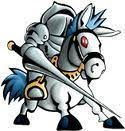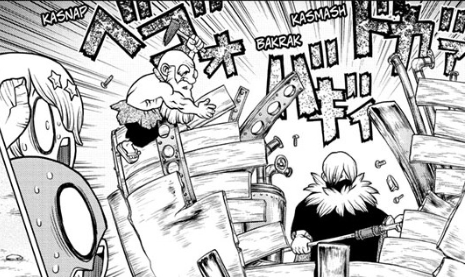Logbook Entry 199: Superalloys
- aboardtheperseus

- Jun 8, 2021
- 6 min read

From the chapter title, superalloys refer to high performance alloys (mixed metals) that have an ability to operate at a high fraction of their melting point. They're based of nickel, iron-nickel, and cobalt alloys. Superalloys are highly utilized by aviation, aerospace, power, and chemical industries. They're used as structural materials and as heavy duty equipment that can handle extremely harsh conditions.

Thematically, superalloys can be used to refer to the joint efforts between Senku and Xeno’s groups in this chapter. It can also mean the collective variety of talents of each and every character.
The chapter kicks off with a dialogue box informing us that Xeno has joined the party. This is the first time we've had one of these dialogue boxes since Chelsea joined the group in chapter 173.

And with Xeno involved, we know Science is on the way. It's one of the most science-packed chapters in the series, beginning with the extraction of argon (Ar) from the atmosphere. The air around us is 78% nitrogen, 21% oxygen, and less than 1% argon. These different gases will liquefy at different temperatures. A single substance can be extracted by fractional distillation. This means the mixture is held at specific temperatures to allow one substance to evaporate while leaving the rest behind.
The extracted argon will be used to construct a Geiger counter. For a simpler definition, a Geiger counter is a device used to detect and measure all kinds of radiation, alpha, beta, and gamma radiation.

The argon is trapped in a tube and a strong current is applied. Were you as confused as Suika was? What does high-voltage electricity do to argon gas? It’s not the electricity, it’s the radioactive elements in the minerals. Once they're picked up by the argon gas, the gas becomes conductive. The electric current is only to alert the user that the radiation (and the minerals giving it off) is nearby. Xeno says a Geiger counter can be made from a lighter because butane gas also influences electric current, though it’s the opposite of argon’s effect, so they are probably used together.
Chrome is the one left in charge of the Geiger counter, not the first time he has worked with such a device. In the Age of Exploration arc, he worked with a metal detector to look for an iron ore deposit. But even the mine he discovered back then had ‘safe’ metals in it. A Geiger counter means having to unearth metals that are radioactive in nature and carry a great risk while being mined. Gives you an idea of what kind of Science Xeno dabs in.
Using the Geiger counter, they unearth several metals and minerals. None of which we have seen in the story before.
These include:

a) Ilmenite – radioactive, heavy iron-titanium oxide used in high-performance, lightweight alloys. Found in abundance on the moon. Very durable and has a high resistance to weathering. Primary ore source of titanium. Commonly used in pigments, highly reflective material, polishing compounds, high-performance parts and tools from aircraft to artificial human joints to sporting goods.

b) Molybdenite - rare molybdenum and sulfur mineral. Properties are similar to graphite. Has a slippery, greasy feel and is used as a solid lubricant. Mostly found in China. This ore contains rhenium, one of the rarest elements which is used in superalloys meant for extreme stress and temperatures. Most of the rhenium found today is used in turbine blades of jet engines.

c) Chromite - chromium, iron, and oxygen oxide ore. Main source of chromium. Difficult to identify. Used to strengthen steel in the creation of stainless steel. Or it can be used with iron and nickel to create nichrome, to handle high temperatures. You’ve probably seen chrome-plated auto parts and appliances, where a thin coat of chromium is applied for strength, durability, rust-resistance, and aesthetics. Chromium is used in yellow paint on roads and school buses.

d) Pyrochlore – describes a specific type of crystal structure that contains metals. It’s radioactive, and is a main source of niobium. Araxa is the world's #1 source of this.

e) Nickel – a metal used mostly to strengthen stainless steel. Improves heat tolerance and resistance to corrosion. Some people are sensitive to it, while it’s essential for animals. Used to make U.S. coins and rechargeable batteries. Like Chrome, it can be used as a plating. 20% of Earth’s core is nickel.

There is one more resource they need to unearth though. Meet our old, but not forgotten friend, the Perseus. After 7 years of neglect, it would obviously be shipwrecked. But even a wrecked ship has its uses, as we see Ryusui, Taiju, Senku and Chrome take apart the ship. The intention is to reuse the iron, but Senku promises Kaseki that they will upgrade the Perseus into something better. This scene mirrors one in chapter 175 where they tear down Xeno’s boat to make the motorcycles.
We switch scenes to Isla Martin Garcia, which is in Argentina. The iron from the Perseus is combined with chromium and processed to acquire stainless steel. You may recognize stainless steel from your cutlery at home. The reason it's used to make things like spoons, knives and forks is because it does not rust, or even corrode. Meaning the appliances can be used for an extended period. It also makes them easy to clean.

Taiju is in the middle of mining, but he quickly gets tired. Which is pretty much a first for him. He never gets tired. At all. He suggests reviving some of the Americans to help in the mines, so Maya and Charlotte get revived from the stone statues. As a character, Taiju himself is not exactly one who distinguishes between evil and good people. He did something similar in America when he asked Carlos to drive with him in the car. In Stone Wars, Taiju took hits from Nikki and was still committed to becoming allies.

Xeno tells Senku that it would make more sense to divide the work; he works on the rocket engine, while Senku works to rebuild a new Perseus. After all, they still need to gather resources from all over the world. Both scientists working on the engine would be detrimental without a Perseus.

Back to the science-y bits of the chapter, Xeno comes up with another invention that refines nickel. The nickel itself is converted into a gas, a gas that Xeno warns the Kingdom of Science about. He is referring to nickel carbonyl, commonly referred to as liquid death. Liquid death poisoning is characterized by a two-stage illness. The first consists of headaches and chest pain lasting a few hours, usually followed by a short remission. The second phase is a chemical pneumonitis which starts after typically 16 hours with symptoms of cough, breathlessness, and extreme fatigue. These reach greatest severity after four days, possibly resulting in death from cardiorespiratory or acute kidney injury. Convalescence is often extremely protracted, often complicated by exhaustion, depression, and dyspnea on exertion. Permanent respiratory damage is unusual.
This scene shares similarities with earlier in the story when they were searching for sulphuric acid. At the time, Senku warned his group about the dangers of such an acid. He also mentioned poisonous gases involved with a horrifying story of accidentally kneeling down into a layer of poison gas. But he did give the group a chance to retreat when the going got tough. When Hyoga and his men were trapped by the toxic gas, Senku meant to use it to keep them away. He did not mean to use it as a real weapon.
Xeno describes himself as a science user of darkness, and Senku a science user of light. Only by combining both their methods of science will they be able to defeat the Why Man. The chapter concludes by informing us that Super Alloy City has been founded. Making it the second of the five major cities they plan to tour. About 30 chapters ago, Corn City was the first city to be formed in Chapter 168. But back then, there was still conflict brewing between Xeno’s and Senku’s forces. We never went into the mechanics of what it really means to set up a city. Does it mean acquiring the necessary resources, and leaving once that has done? Or does it mean lingering around, and establishing a civilization? Much like Ishigami Village?
Loved the chapter. All the science involved was fun to witness, and we also got an update on the Perseus. Personally, I would like them to linger around a bit and mingle with the newly established civilization. We already saw linguistic difference when the crew got to America, what with English and Japanese. The people in Brazil/South America primarily talk Spanish/Portuguese, so it would be interesting to see how Inagaki handles the differences between English/Portuguese/Spanish/Japanese. Xeno’s linguistic skills are maxed out, so it could be a chance to see some of it in work in the story.
But with Senku saying they are short on time; we could very much see the Perseus completed next chapter. And the group embarking onto the third part of their world tour.
Trivia:

-The cover of the chapter shows Suika in an armor, which is an obvious homage to Berserk (Guts Berserker armor). But in Inagaki’s previous work, one of the villain groups was named Oujou White Knights. Their sigil was a knight on a horse holding a lance, so Suika dressed as a knight makes me remember this fondly.
- There's 75 people revived now, with Maya being the 75th. Considering Senku’s comments last chapter about radio silence falling upon the earth, it makes you wonder if there is a limit to the human activity before Why Man starts sensing them. The numbering of jars could be Senku’s method of trying to test out that theory.
























Just as a quick note, I do think Maya is the 75th person revived but there are more than 75 people around. Remember Senku & Suika didn't have numbers assigned for their revival. Also there were 74+2 people before any of the Americans besides Xeno were revived. Point being, I think it's just to gives us a rough estimate on the number of people (somewhere from 80-90 unless several more civilians were revived)